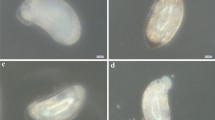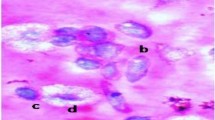Abstract
DURING the course of mass breeding of Microbracon brevicornis in the parasite laboratory of the Entomology Division of this Institute for the purpose of exporting them to the United States of America for the control of pink boll worm in the cotton belt of that country, it was necessary to maintain a stock of pupæ of the parasite in cold storage at a temperature of 10 ± 3° C. It was observed that the adults emerging from the chilled pupæ which had been in cold storage from 10 to 75 days showed dark pigmentation ranging from dark grey to jet black, as against the distinctly brown individuals obtained from unchilled pupæ.
This is a preview of subscription content, access via your institution
Access options
Subscribe to this journal
Receive 51 print issues and online access
$199.00 per year
only $3.90 per issue
Buy this article
- Purchase on Springer Link
- Instant access to full article PDF
Prices may be subject to local taxes which are calculated during checkout
Similar content being viewed by others
References
Kaestner, M., Arch. Entw. Mech., 124, 1 (1931).
Genies, P., C.R. Soc. Biol., Paris, 86, 767, 1080 (1922). Schlottke, E., Z. vergl. Physiol., 3, 692 (1926). Kuhn, Nachr. Ges. Wiss. Göttingen Math. Phys. Kl., 407, (4) (1927).
Cordier, R., Ann. Bull. Soc. Roy. Sci. Med. Nat. Brux., 43 (1928).
Author information
Authors and Affiliations
Rights and permissions
About this article
Cite this article
NARAYANAN, E., ANGALET, G., SUBBA RAO, B. et al. Effect of Refrigeration of the Pupæ of Microbracon brevicornis Wesm. on the Pigmentation of the Adult. Nature 173, 503–504 (1954). https://doi.org/10.1038/173503b0
Issue Date:
DOI: https://doi.org/10.1038/173503b0
Comments
By submitting a comment you agree to abide by our Terms and Community Guidelines. If you find something abusive or that does not comply with our terms or guidelines please flag it as inappropriate.



